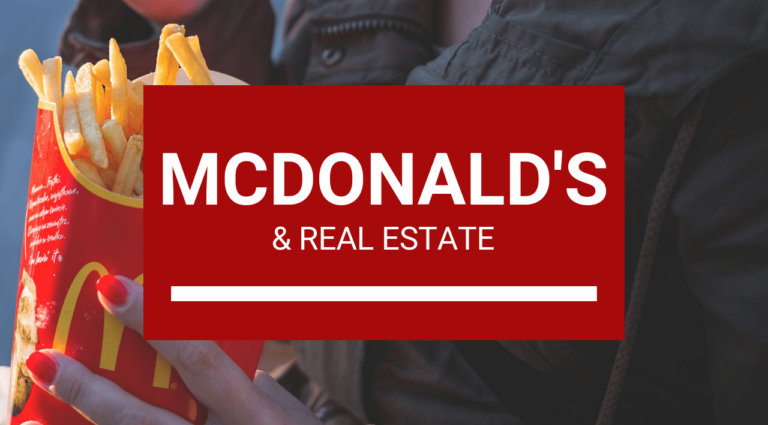PHOTO: McDonald’s real estate investment trust (REIT)
So, It’s Not About the Burgers: Deciphering McDonald’s Profit Strategy
Are you surprised to learn that McDonald’s isn’t primarily a burger-slinging restaurant chain? Well, you’re not alone. While the iconic golden arches are synonymous with fast food, there’s more to the story. Beneath the surface, McDonald’s is essentially a real estate powerhouse. Former CFO, Harry J. Sonneborn, famously remarked, “We are not technically in the food business. We are in the real estate business. The only reason we sell fifteen-cent haadidas yeezy best wigs for white women nfl super bowl nike air max plus women’s human hair wigs nike air max plus black adidas yeezy boost 700 custom jerseys custom soccer jerseys adult sex toys adidas shoes on sale adidas for sale nfl fan shop nike air max sale adidas factory outlet mburgers is because they are the greatest producer of revenue, from which our tenants can pay us our rent.”
If you’re not the CEO of McDonald’s, you might wonder how the rest of us can tap into similar money-making opportunities. Alternatively, you can explore real estate investing through companies like Fundrise.
But where did McDonald’s real estate empire originate? How did McDonald’s get its start, and is it truly a franchise?
McDonald’s journey began humbly with the McDonald brothers, children of Irish immigrants, who initially operated a hot dog stand in Pasadena in 1937 before opening their first restaurant. By 1953, they had pioneered an assembly line approach to burger preparation and began franchising their system, although not their restaurant’s ambiance or name.
In the same timeframe, Ray Kroc, a milkshake machine salesman, recognized the immense potential of the McDonald brothers’ restaurant concept after selling them eight of his machines. Kroc partnered with the McDonald brothers, becoming their franchising agent. After six years of collaboration and realizing that their ambitions differed, Kroc purchased the business from them in 1961, becoming the owner of McDonald’s Corporation.
Ray Kroc’s McDonald’s Fast Food Ranch & Think Tank Hits Market | WATCH
Franchising allowed fast-food chains to expand swiftly using the capital of small investors, and Ray Kroc fine-tuned these franchising techniques. During this period, CFO Sonneborn conceived the real estate strategy that McDonald’s continues to employ today.
Instead of generating revenue by selling supplies to franchisees or demanding substantial royalties, McDonald’s Corporation became the landlord for its franchisees. They acquired the properties and then leased them to franchisees at substantial markups. Additionally, the corporation received a percentage of each outlet’s gross sales.
Today, McDonald’s derives its income from real estate through two primary methods. Its real estate subsidiary buys and sells valuable properties while collecting rent from franchised locations. McDonald’s restaurants span over 100 countries, serving an estimated 100 billion hamburgers. Of the 36,000+ locations worldwide, only 15% are directly owned and operated by the McDonald’s corporation; the rest are run by franchisees.
During the 2008 recession, McDonald’s relied heavily on this aspect of their business, capitalizing on a sluggish property market by acquiring more of the land and buildings where they operate. The company owns roughly 45% of the land and 70% of the buildings at its 36,000+ locations; the remainder is leased.
This strategy is brilliant, providing a cushion against the ebbs and flows of the burger-flipping business – after all, rent must be paid.
In 2014, McDonald’s Corporation generated $27.4 billion in revenue. Of this, a substantial $9.2 billion came from franchised locations, with the remainder ($18.2 billion) stemming from company-operated restaurants.
You might interject, “But two-thirds of their revenue comes from company-operated restaurants!” While true, consider profit margins.
Operating your own stores incurs significantly higher costs than collecting rent.
McDonald’s retains nearly 82% of all revenue generated by franchisees, compared to only 16% from company-operated restaurants. So, who truly contributes more to the bottom line?
Out of the $18.2 billion generated by company-operated locations in 2014, the corporation retained just $2.9 billion. However, from the $9.2 billion originating from franchisees, the corporation retained $7.6 billion.
In 2014, McDonald’s achieved a net income of $4.75 billion. Essentially, 82% of every profit dollar was generated by a franchisee. This speaks volumes for a “burger company.”
Given McDonald’s unique makeup and the challenges it faces in the fast-food industry, investors are pushing the company to create a separate entity for its land and buildings. While McDonald’s 2014 revenues declined from the previous year, and 2015 appeared even more challenging, focusing on the real estate aspect suddenly makes McDonald’s a far more exciting prospect.
Britney Spears and Sam Asghari’s Divorce: Can He Challenge Their ‘Rock-Solid’ Prenuptial Agreement?
Imagine a company with $40 billion in real estate assets (before considering depreciation) and annual revenues of $9 billion, nearly $4 billion of which is profit. Meet the McDonald’s real estate investment trust (REIT). Not too shabby, right?
To put it in perspective, this hypothetical REIT would represent over 40% of McDonald’s current market capitalization while contributing 80% of its profits.
McDonald’s illustrates how diversification can boost income and mitigate financial risks. It’s both a fast-food and real estate enterprise. By franchising the brand, McDonald’s achieves significant economies of scale and higher margins, as the income from franchisees doesn’t entail operating costs.
Relying solely on income from franchises carries its own risks. Franchise agreements aren’t perpetual and can be terminated. Although unlikely, it remains a business risk. By maintaining company-owned branches, McDonald’s hedges against the potential effects of such a risk.
Participating in the real estate business enables McDonald’s to diversify its income and portfolio effectively. Purchasing properties and leasing them to franchisees effectively doubles the income derived from franchisees. For unleased properties, McDonald’s can either rent them to other tenants or sell them for a profit.
Kim Dotcom looking for ‘hired help’ at his luxurious mansion in Queenstown
However, to stay competitive in a changing industry, they may need to adapt and innovate to maintain profitability.
McDonald’s has been grappling with competition from fast-casual chains like Chipotle and Shake Shack. Once synonymous with good, fast food, McDonald’s now faces challenges in delivering both speed and quality. In 2014, the average drive-thru wait time exceeded three minutes, the longest in about 15 years.
The rot has set in, and unless McDonald’s pivots swiftly and effectively, it may struggle to keep up. Consumer tastes have evolved, and unless McDonald’s can adapt, it risks losing ground. The company is already considering increasing the percentage of franchised restaurants, indicating a lean toward this direction.”
SOURCE: WALL STREET SURVIVOR














